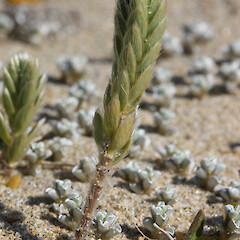Pimelea lyallii
Synonyms
None
Family
Thymelaeaceae
Flora category
Vascular – Native
Endemic taxon
Yes
Endemic genus
No
Endemic family
No
Structural class
Trees & Shrubs - Dicotyledons
NVS code
The National Vegetation Survey (NVS) Databank is a physical archive and electronic databank containing records of over 94,000 vegetation survey plots - including data from over 19,000 permanent plots. NVS maintains a standard set of species code abbreviations that correspond to standard scientific plant names from the Ngä Tipu o Aotearoa - New Zealand Plants database.
PIMLYA
Current conservation status
The conservation status of all known New Zealand vascular plant taxa at the rank of species and below were reassessed in 2017 using the New Zealand Threat Classification System (NZTCS) – more information about this can be found on the NZTCS website. This report includes a statistical summary and brief notes on changes since 2012 and replaces all previous NZTCS lists for vascular plants.
Please note, threat classifications are often suggested by authors when publications fall between NZTCS assessment periods – an interim threat classification status has not been assessed by the NZTCS panel.
- Conservation status of New Zealand indigenous vascular plants, 2017 . 2018. Peter J. de Lange, Jeremy R. Rolfe, John W. Barkla, Shannel P. Courtney, Paul D. Champion, Leon R. Perrie, Sarah M. Beadel, Kerry A. Ford, Ilse Breitwieser, Ines Schönberger, Rowan Hindmarsh-Walls, Peter B. Heenan and Kate Ladley. Department of Conservation. Source: NZTCS and licensed by DOC for reuse under the Creative Commons Attribution 4.0 International licence.
2017 | At Risk – Declining | Qualifiers: CD, DP, RR, Sp
Previous conservation statuses
2012 | At Risk – Naturally Uncommon | Qualifiers: RR, Sp
2009 | At Risk – Naturally Uncommon
2004 | Gradual Decline
Brief description
Low growing shrub with flexible twigs bearing crowded pairs of pointed leaves that are densely hairy underneath inhabiting dunes in southern New Zealand. Twigs usually buried in sand. Leaves 5–7 mm long by 2–3 mm wide. Flowers hairy, white, in clusters at tip of twigs. Fruit white.
Distribution
Endemic. Confined to the Foveaux Strait and Stewart Island/Rakiura coastline.
Habitat
Coastal in sand dunes and their associated swales.
Wetland plant indicator status rating
Information derived from the revised national wetland plant list prepared to assist councils in delineating and monitoring wetlands (Clarkson et al., 2021 Manaaki Whenua – Landcare Research Contract Report LC3975 for Hawke’s Bay Regional Council). The national plant list categorises plants by the extent to which they are found in wetlands and not ‘drylands’. The indicator status ratings are OBL (obligate wetland), FACW (facultative wetland), FAC (facultative), FACU (facultative upland), and UPL (obligate upland). If you have suggestions for the Wetland Indicator Status Rating, please contact: [Enable JavaScript to view protected content]
FACU: Facultative Upland
Occasionally is a hydrophyte but usually occurs in uplands (non-wetlands).
Detailed description
A small to medium-sized shrub. Stems prostrate, flexible, up to 600 mm long, sometimes producing adventitious roots if buried by sand. Young branches ascendant and moderately to densely clad in long, white (sometimes yellowish) hairs; internode length 2.5–8.0 mm; older stems sparsely hairy to glabrous, brown. Node buttresses short, lunate (0.3–0.5 mm), smooth, brown, hairless, or with sparse, short hair, masked by internode hair on young stems, not prominent on leafless stems. Leaves usually distant, sometimes closely spaced and imbricate, ascendant, then patent or deflexed, persistent, on short (0.5 mm), often red petioles; lamina pale green, glabrous above, moderately densely to densely covered in white to yellowish hair below (also along margins and at tip); 5–7 × 2–3 mm wide, elliptic to slightly ovate, flat to slightly concave above, midvein obscure below; acute, base cuneate. Stomata on both leaf surfaces. Inflorescences terminal on branchlets, loose, 3–4-flowered, sometimes clustered in groups of 2 or more; receptacles flat to convex, very hairy. Involucral bracts 4, up to 9 × 3 mm, sometimes with a few hairs on the upperside near the base, densely hairy below and on margins and tips. Plants gynodioecious. Flowers white, on short pedicels (0.5 mm); tube and calyx lobes very hairy outside; inside hairless; female tube 3.5 mm long, ovary portion 3 mm, calyx lobes 1.2 × 0.9 mm; hermaphrodite tube 5 mm long, ovary portion 2 mm, calyx lobes 2.0 × 1.6 mm. Anther filaments inserted at mouth of tube; anther yellow. Ovary very hairy at summit. Fruits ovoid, fleshy, 5.0 × 3.8 mm, white, opaque. The tube breaks off, irregularly, near the base as the fruits ripen. Seeds pyriform, with thin crest, 2.5 × 1.8 mm. Description based on Burrows (2009).
Similar taxa
Pimelea lyallii is easily recognised within its natural habitat because it is the only species found within active to semi-stable dune fields. P. lyallii could only be confused with plants currently attributed to P. prostrata. From this it is perhaps best distinguished by its longer leaves and flower perianths. Herbarium material is less easily resolved, particularly when it is sterile.
Flowering
October–April
Flower colours
White
Fruiting
November–April
Propagation technique
Easy from semi-hardwood cuttings but difficult to maintain in cultivation.
Threats
Widespread along the south Otago, Foveaux Strait and Stewart Island/Rakiura coastlines but its range is contracting in the northern part due to dune consolidation, coastal development and the spread of weeds.
Etymology
pimelea: Pimeleoides means “resembling Pimelea’’, a genus in the family Thymelaeaceae (Greek, -oides = resembling, like).
lyallii: Named after David Lyall (1817-1895), 19th century Scottish naturalist and surgeon with the Royal Navy, who explored Antarctica, New Zealand, the Arctic and North America and was a lifelong friend of Sir Joseph Hooker.
Where To Buy
Occasionally available from some specialist native plant nurseries.
Notes on taxonomy
New Zealand Pimelea Sol. ex Gaertn. urgently require a full taxonomic revision using modern techniques.
Attribution
Description based on Burrows (2008).
References and further reading
Burrows CJ. 2009. Genus Pimelea (Thymelaeaceae) in New Zealand 3. The taxonomic treatment of six endemic hairy-leaved species. New Zealand Journal of Botany 47(3): 325–354. https://doi.org/10.1080/00288250909509813.










